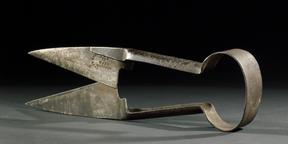

1:4 scale model of lever horse hoe with detachable shafts

Model (Scale 1:4) of lever horse hoe with detachable shafts by Richard Garrett & Sons of Leiston, embodying patents of 1842 and 1849, and shown at the Great Exhibition, 1851
The function of the horsehoe was to aerate the top soil in order to prevent the evaporation of soil moisture and to uproot the annual weeds in the spaces between the rows of growing field crops. The original hosehoe, introduced by Jethro Tull early in the 18th century, was rather a crude implement, resembling a roughly shaped swing plough, without a mouldboard and with the cutting edge of the share turned up the landside. Horsehoes continued to be of simple, character, generally resembling swing ploughs with hoes until the early 19th century from when they became increasingly diversified in both structure and adaptation.
This model was shown at the 1851 Exhibition and embodies inventions patented in 1842 and 1849. It was regarded as one of the most efficient implements of its kind. Each of 14 hoes, 2 per drill space, are carried on a separate lever allowing the hoe to pass undamaged over any obstruction. Each hoe is adjustable to suit the drill spacing, and sideways adjustment of the complete set is possible to keep the hoes accurately positioned between the rows of young pants regardless of any irregularity in the movement of the horse. The travelling wheels are mounted on separate axle trees for additional gauge adjustment and when required, the whole set of hoes can be lifted clear of the ground by means of single lever.
Details
- Category:
- Agricultural Engineering
- Object Number:
- 1894-161
- Materials:
- iron, metal (unknown) and wood (unidentified)
- Measurements:
-
overall: 295 mm x 465 mm x 540 mm, 7.526 kg
overall (detachable part, laid flat): 35 mm x 240 mm x 665 mm, .394 kg
- type:
- model
- credit:
- On loan from R. Garrett and Sons




